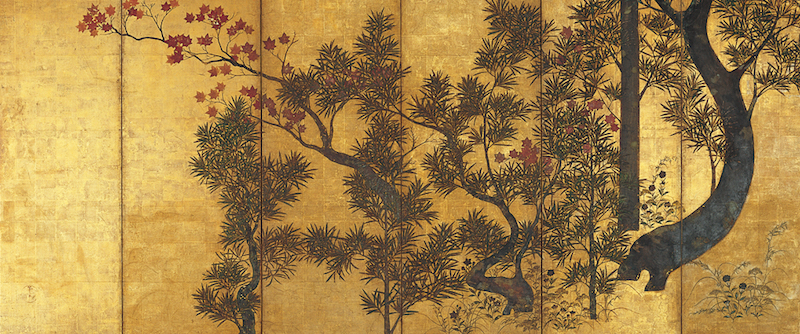Past Exhibition
Special Exhibition:
The Rimpa School
―from Tawaraya Sōtatsu to Tanaka Ikkō

Attributed to Tawaraya Sōtatsu,
Chinese Black Pines and Maple Trees,
Yamatane Museum of Art
12 May (Sat.) – 8 July (Sun.) 2018
(Closed on Mondays)
Hours:10 am - 5 pm (Last admission at 4:30 pm)
Admission Fees: Adults: 1,200 [1,000] yen; university and high school students: 900 [800] yen; middle school and younger children: free of charge
*Figures in brackets are for groups of 20 or more, advance tickets, repeaters with used tickets for this exhibition and those who are wearing kimono.
*Disability ID holders and one person accompanying them are admitted free of charge.
Organized by: Yamatane Museum of Art and Nikkei Inc.
This year marks two significant milestones for the Rimpa School: the 190th anniversary of the death of Sakai Hōitsu (1761-1828) and the 160th of the death of Suzuki Kiitsu (1796-1858). To commemorate them, the Yamatane Museum of Art is holding a special exhibition on the Rimpa tradition, which originally flowered with Tawaraya Sōtatsu, Ogata Kōrin, and Sakai Hōitsu as its central figures and has been sustained by modern and contemporary nihonga artists as well as designers.
In the seventeenth century, Sōtatsu, an active member of the Kyoto art world, built on Yamato-e style foundations but made use of deformé and trimming to establish a richly decorative style with striking design qualities. That style was carried on by Kōrin in the eighteenth century. In the nineteenth century, Hōitsu, who was from a daimyo family, elevated it to even greater sophistication and established Edo Rimpa as a style.
This exhibition, which is focused on works from our museum’s Rimpa collection, presents a bevy of Rimpa masterpieces in one setting, including Fragment of the Shinkokinshū Poetry Anthology: Deer, a collaborative work with painting by Sōtatsu and calligraphy by Hon'ami Kōetsu (Yamatane Museum of Art), Kōrin’s The Chinese Poet Bai Juyi: A Scene from the Noh Play Hakurakuten, Hōitsu’s Autumn Plants and Quails (Important Art Object; Yamatane Museum of Art), and Kiitsu’s Birds and Flowers of the Four Seasons (Yamatane Museum of Art). Most notably, it will include our museum’s recently restored Chinese Black Pines and Maple Trees, attributed to Sōtatsu, which will be displayed for the first time since its restoration carried out last year under a Sumitomo Foundation grant for the protection, preservation, and restoration of cultural properties.
In addressing the ways in which the Rimpa legacy has been carried on by modern and contemporary artists, we introduce, in the nihonga field, the work of Rimpa-influenced artists such as Hayami Gyoshū and Kayama Matazō.
In addition, we also present posters by the graphic designer Tanako Ikkō (1930-2002), who stated that “Rimpa provides the prototype for Japanese forms.” We thus explore the fascination of Rimpa art and design as transmitted and transformed from its beginnings in the seventeenth century with Sōtatsu and Kōetsu to Tanaka Ikkō in the twentieth century.
In conclusion, we would like to express our profound gratitude to the institutions and individuals who graciously allowed works in their collections to be exhibited and to the many others whose cooperation helped make this exhibition.
 Hayami Gyoshū, Emerald Mosses and Verdant Turf, Yamatane Museum of Art |












